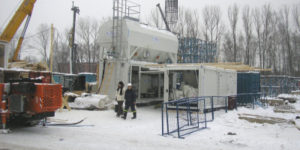 Colder weather is on the horizon, which means it’s time to think about making sure your equipment is prepared for the long cold months ahead. In this two-part article, we’ll take you through the dos and don’ts of getting your foundation equipment ready and keeping them, and your jobsites, operating efficiently and safely.
Colder weather is on the horizon, which means it’s time to think about making sure your equipment is prepared for the long cold months ahead. In this two-part article, we’ll take you through the dos and don’ts of getting your foundation equipment ready and keeping them, and your jobsites, operating efficiently and safely.
It all starts with having a plan — an expertly designed service and parts plan to winterize and to keep commonly needed parts within reach.
Part 1 — Winterizing
Working with a service expert, like the ones at IDE, you can build and schedule an exact, step-by-step plan to winterize equipment and minimize downtime. To give you an idea of what this entails, the team at IDE put together the following general winterization checklist. Keep in mind, it’s just a starting point.
General Hazards
-
- Check cooling system fluids for resistance to freezing. Consider cleaning and flushing.
- Keep fuel tanks full. Consider winterizing fuel (anti-gel) additives and switching to winter fuels.
- Monitor fuel filters and separators for condensate accumulation.
- Keep hydraulic tanks at full mark. Consider switching to lighter hydraulic oils if manufacturers advise.
- Check gear box fluid levels. Consider switching to lighter gear oils, if advisable.
- Keep batteries fully charged.
- Consult engine manufacturer to see if lighter winter motor oils are advised.
- Be especially cautious of DEF storage systems. DEF freezes at 12°F and expands by 7% when frozen.
- Clean equipment. Dirt and mud that adhered during warmer temperatures can become like concrete when frozen.
- Do not let snow or mud accumulate in undercarriage.
- Make repairs before freezing sets in. Cold steel is hard on hands.
- Photograph outdoor equipment and facilities before it snows.
- Watch out for equipment shipped from warm climates to cold climates.
- Change engine fans from summer to winter if advisable.
- Check engine belts and hoses for cracking. They can become brittle in cold weather.
- Inspect engine intakes and exhausts for weather integrity.
- Use block heaters when so equipped.
- Inspect radiator shutter/covers for proper operation.
- Inspect starting fluid mechanisms, if so advised and equipped.
The key is staying ahead of the weather. By that, we mean that most of the items on this checklist should be done before winter gets here. Then by regularly checking, inspecting and servicing equipment throughout the winter, you stand a better chance of keeping it up and running.
While the above checklist applies to most construction equipment, you’ll want to pay close attention to some potential on-the-job trouble spots that are specific to drilling and grouting equipment. Following these extra steps on the jobsite during winter can save you unnecessary downtime and headaches.
Drill Rig Hazards
-
- Blow out concrete and grout lines after flushing with water.
- Blow out flushing pumps.
- Blow out misting and foaming pumps.
- Blow out pressure washing equipment and hoses.
- Drain water out of low spots on hoses.
- Apply air alcohol to pneumatic components as appropriate.
- Plank tracks up out of the mud at night.
- Keep tooling, especially DTHH’s, stored vertically.
Grout Equipment Hazards
-
- Blow out grout lines after flushing with water.
- Drain grout transfer lines.
- Drain grout mixing and holding tanks. Leave plugs out.
- Cover equipment and/or tanks to prevent snow from accumulating and then freezing. Snow doesn’t run out of drain plugs.
- Add antifreeze to locations that accumulate precipitation.
Keep in mind: winter is tough on equipment and people. Even the most-prepared, best-run sites can get breakdowns. (That is why you’ll also want to head into the season with a good parts strategy and inventory. More on that in part two of this article.) But this is where having the right service partner and a solid service plan makes a big difference.
For instance, IDE stands with clients, partnering to help make them more successful by winterizing the right way, planning service to keep them up and running throughout the cold winter months, and minimizing downtime through expert repair and quality parts.
We invite you to talk with one of our service experts about how to make sure your equipment is ready for winter. In the meantime, look for part two of our Planning for a Productive Winter series coming soon.

Recent Comments